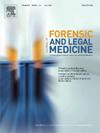In vitro β-hydroxybutyrate stability evaluation in femoral blood and vitreous humor for integration into forensic toxicology practices
IF 1.2
4区 医学
Q3 MEDICINE, LEGAL
引用次数: 0
Abstract
Thanatological biochemistry has gained prominence in determining causes of death, especially when suspected fatal pathologies do not exhibit clear postmortem macroscopic and/or microscopic features, such as in cases of ketoacidosis. Indeed, in these cases, the measurement of β-hydroxybutyrate (BHB) in femoral blood and/or vitreous humor is of particular importance. However, data on its in vitro stability remain scarce, especially in vitreous humor. In this context, the study reported here aims to assess the in vitro stability of BHB. BHB quantification was performed using a liquid chromatography coupled with tandem mass spectrometry method. To investigate BHB stability, two different postmortem matrices were considered: femoral blood and vitreous humor. These matrices were pooled, aliquoted and spiked with BHB at three different concentrations (50 mg/L, 100 mg/L, and 200 mg/L; n = 3). Initial BHB concentrations were established on day 1. Each sample was then divided into two aliquots for storage under two conditions: 20 °C and 4 °C. Analyses were performed on Day 3, 7, 14, and 28. The study revealed no significant degradation of BHB in femoral blood or vitreous humor over time (days 1–28), confirming the robustness and reliability of BHB measurement in these matrices as a postmortem biomarker of ketoacidosis under the tested temperature conditions (+4 °C or −20 °C). These results support a systematic integration of BHB measurement into the routine workflow of forensic toxicology laboratories.
用于法医毒理学实践的股血和玻璃体中β-羟丁酸体外稳定性评估
在确定死亡原因方面,尤其是当疑似致命病症在死后的宏观和/或微观特征不明显时,如在酮症酸中毒病例中,解剖生化已变得越来越重要。事实上,在这些病例中,测量股静脉血和/或玻璃体中的β-羟丁酸(BHB)尤为重要。然而,有关其体外稳定性的数据仍然很少,尤其是在玻璃体液中。在这种情况下,本文报告的研究旨在评估 BHB 的体外稳定性。研究采用液相色谱-串联质谱法对 BHB 进行定量。为了研究 BHB 的稳定性,研究人员考虑了两种不同的尸检基质:股骨头血液和玻璃体。将这些基质汇集、等分并添加三种不同浓度(50 毫克/升、100 毫克/升和 200 毫克/升;n = 3)的 BHB。BHB 初始浓度在第 1 天确定。然后将每个样品分成两份等分样品,分别在 20 °C 和 4 °C 两种条件下储存:20 °C 和 4 °C。在第 3、7、14 和 28 天进行分析。研究结果表明,随着时间的推移(第 1-28 天),股静脉血或玻璃体液中的 BHB 没有明显降解,这证实了在测试温度条件(+4 °C或-20 °C)下,在这些基质中测量 BHB 作为酮症酸中毒死后生物标志物的稳健性和可靠性。这些结果支持将 BHB 测量系统地纳入法医毒理学实验室的常规工作流程。
本文章由计算机程序翻译,如有差异,请以英文原文为准。
求助全文
约1分钟内获得全文
求助全文
来源期刊

Journal of forensic and legal medicine
MEDICINE, LEGAL-
CiteScore
2.70
自引率
6.70%
发文量
106
审稿时长
57 days
期刊介绍:
The Journal of Forensic and Legal Medicine publishes topical articles on aspects of forensic and legal medicine. Specifically the Journal supports research that explores the medical principles of care and forensic assessment of individuals, whether adult or child, in contact with the judicial system. It is a fully peer-review hybrid journal with a broad international perspective.
The Journal accepts submissions of original research, review articles, and pertinent case studies, editorials, and commentaries in relevant areas of Forensic and Legal Medicine, Context of Practice, and Education and Training.
The Journal adheres to strict publication ethical guidelines, and actively supports a culture of inclusive and representative publication.
 求助内容:
求助内容: 应助结果提醒方式:
应助结果提醒方式:


